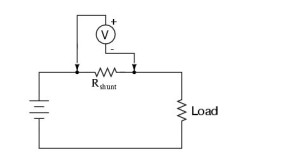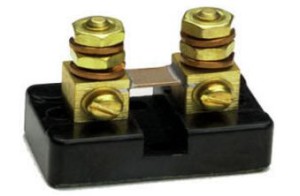Current Draw spring 2016
Posted by: Luis Valdivia(Project Manager)
Written by: Kevin Nguyen(Electronics and Controls)
Table of Contents:
– Introduction
– Shunt Resistor
– Results
Introduction:
We encountered a problem while measuring the current draw of the motors; the motors were drawing too much current for the multimeter to read. To solve this, we used a shunt resistor setup to measure the voltage across the resistor and calculate our current draw. Using this method, we can avoid directly measuring the high current which could damage our multimeter.
Fig 1.1 Shunt Resistor Setup
This setup is used to measure the current draw of high powered devices. Our load would be the motors and the supply is a 14V source.
Shunt Resistor:
The specs of the shunt resistor is 300A, 50mV. That means that the resistor would have a 50mV voltage drop at the maximum current of 300A. Since Ohm’s Law says that the voltage is proportional to the current across a resistor, we can simplify that to 6A per mV. Knowing this, we can calculate the current draw by multiplying the measured voltage by 6A/mV.
Another alternative to calculating the current draw would be to calculate the resistance of the shunt and divide that by the measured current draw. Using Ohm’s Law we can calculate the resistance of the shunt to be:
50mV = 300A*R
R = 50mA/300V = 0.1666mOhms
Shunt Resistors typically have very small values so that it doesn’t affect the circuit. The tolerance is very small, 0.1%, for accurate measurements. To measure the current draw using this method, we divide the measured voltage by 0.16666mOhms.
Those two methods described above are 2 ways of realizing an identical solution. Multiplying by 6 is the same as dividing by 0.16666.
Fig 1.2 Shunt Resistor
Low Resistance, Low Tolerance resistor that serves many applications. One of its purposes could be used for measuring high current.
Results:
Using this method we were able to accurately measure the current draw of our high powered motors. The results we got was that each motor drew approximately 11.85A at full throttle with our setup. 4 Motors would draw a total of 47.4A. Using this data, we determined that our battery was safe to use with these motors. The battery we have is capable of safely supplying 135A continuous load current which is far above what we require.


